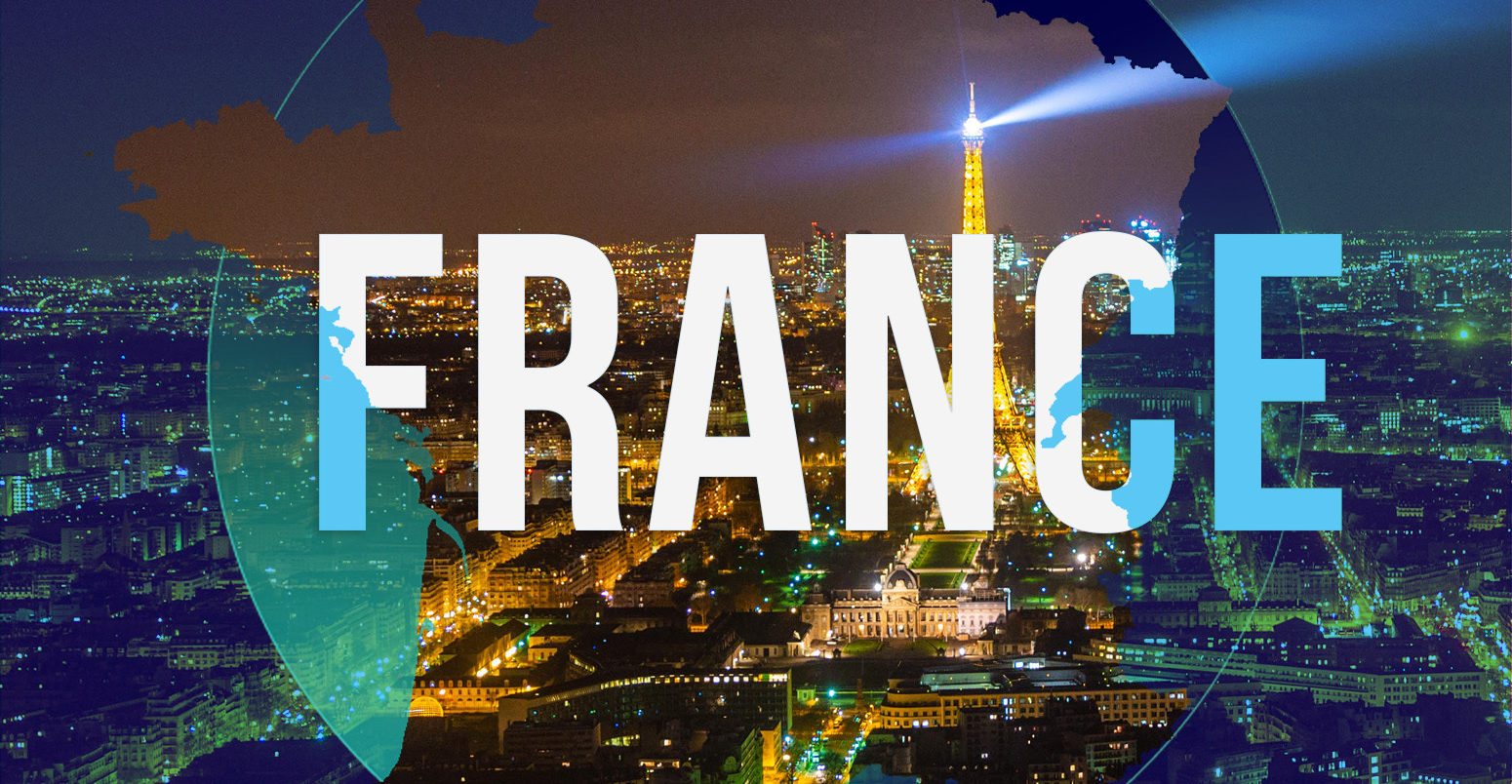In this country profile, Carbon Brief examines the state of climate and energy policies in France, a major emitter that nevertheless relies on fossil fuels less than any other industrialised nation.
It was the world’s 25th largest greenhouse gas emitter in 2018, ranking lower than similarly sized European neighbours, such as the UK and Italy.
This is largely due to France’s position as the third-largest producer of nuclear power, which provides the country with more than two-thirds of its electricity.
While this means its power-sector emissions are relatively low, it obscures the slow expansion of French wind and solar, as well as high emissions from the nation’s roads and farmlands.
In recent years, France has often framed itself as a global leader on climate change, famously hosting the COP21 summit that resulted in the Paris Agreement.
However, French climate policy under its current president, Emmanual Macron, has been tumultuous. The government has consistently missed targets and faced lawsuits, plus backlash from some citizens over its policies.
As the nation approaches the conclusion of its presidential election, the next leader faces the prospect of steering French emissions onto a downward trajectory and implementing policies that comply with the EU’s latest, more ambitious targets.
(Update 25/04/2022: Macron won the presidential election, beating his far-right rival Marine Le Pen, who still managed to secure her party’s highest share of the vote yet. In the final days of campaigning, Macron vowed a “complete renewal” of climate policy in what was seen as a bid to win over left-leaning voters. This rhetoric included a pledge to end the use of fossil fuels in France and make it “the first great nation to exit oil, gas and coal”.)
(Update 29/06/2022: The centrist alliance led by Macron lost its absolute majority in the lower house of French parliament, leaving them searching for a power-sharing agreement in order to avoid political deadlock. The left-wing coalition NUPES – the New Ecological and Social Popular Union – was the largest opposition group, and while they and Macron’s Ensemble! have made climate change a priority, both were quiet on the issue during campaigning.)
- Politics
- Paris pledge
- Climate policies and laws
- Nuclear
- Renewables
- Fossil fuels
- Transport
- Agriculture
- Impacts and adaptation
Politics
France is a high-income nation, which, as of 2020, had the world’s seventh-largest GDP and the third-largest in Europe, according to World Bank figures. It is the second most populous country in the EU, with around 67 million inhabitants.
The COP21 climate summit in 2015, hosted in Paris, saw the nation’s capital city enshrined in the name of the Paris Agreement, the main international treaty to address climate change.
Since his election in 2017, president Emmanuel Macron has often presented his nation as a climate leader on the world stage, pledging to “make our planet great again” after the US moved to withdraw from the agreement. Domestically, Macron has faced criticism for failing to match his rhetoric with sufficient action.
According to polling by the Pew Research Centre, 83% of French people in 2020 viewed climate change as a “major threat” to the country, considerably more than neighbouring countries, such as the UK and Germany.
While “yellow vests” protests against Macron’s fuel-tax increases in 2018 were widely interpreted as anti-climate action, they had a broad focus that took in the cost of living and the state of politics in general. Nevertheless, they have had a lasting impact on climate politics in France. (See: Climate policies and laws.)

At the end of 2020, the government announced its “France relaunch” plan to aid recovery from Covid-19, including €30bn for building renovations, transport, agriculture and energy. The nation saw its GDP expand 7% in 2021, its strongest growth in more than five decades.
Formerly one of the largest colonial powers, most French colonies became independent in the 1960s following a series of revolts. Many have maintained close ties with France, while others from the Caribbean to the South Pacific have remained as overseas territories.
France’s semi-presidential political system began with the Fifth Republic in 1958, following the collapse of the previous republic amid the Algerian War of Independence.
Powers are split between the president, who is directly elected by the public and serves as head of state, and the prime minister, who is chosen by the president and acts as head of government.
French citizens vote for the 577 members of the National Assembly, the lower house of parliament, while the upper house of the Senate has its 328 members elected by an electoral college of representatives from across the country.
Traditionally, French politics has been dominated by two parties, the centre-left Socialist Party and the centre-right Republicans, which have typically formed coalitions with sympathetic smaller parties. Both have shown some support for climate action, although with different approaches that reflect their politics.
The Socialists are the more climate-focused party of the two, prioritising the principles of “social-ecology”. Socialist president François Hollande alluded to the importance of climate justice in his opening speech at the COP21 summit in 2015.
The Republicans have tended to favour market mechanisms, such as carbon pricing, and the last Republican president, Nicolas Sarkozy, presented a suite of tax measures and spending as the start of a “green revolution” in France back in 2007.
Today, the right-wing of French politics is more sceptical about environmental policies and has been instrumental in holding back the ambition of recent climate policies.
This largely two-party system shifted during the 2017 elections, which saw a face-off for the presidency between Marine Le Pen of the far-right National Front – known since 2018 as National Rally – and Macron, who led the newly formed centrist party La République En Marche! (LREM).
In the subsequent legislative election to elect the National Assembly, LREM and their allies won a large majority of 350 seats, dramatically reducing the numbers held by Republicans and Socialists.
This face-off between Macron and Le Pen is now set to play out once again in the 2022 presidential election, as both candidates emerged on top in the first round of voting and support for the traditional parties collapsed.
While climate was not top of the agenda when LREM came to power, Macron and his party have been under pressure to implement more ambitious climate policies. This has culminated in the development of a new climate bill, based on the input of a citizens’ assembly. (See: Climate policies and laws.)
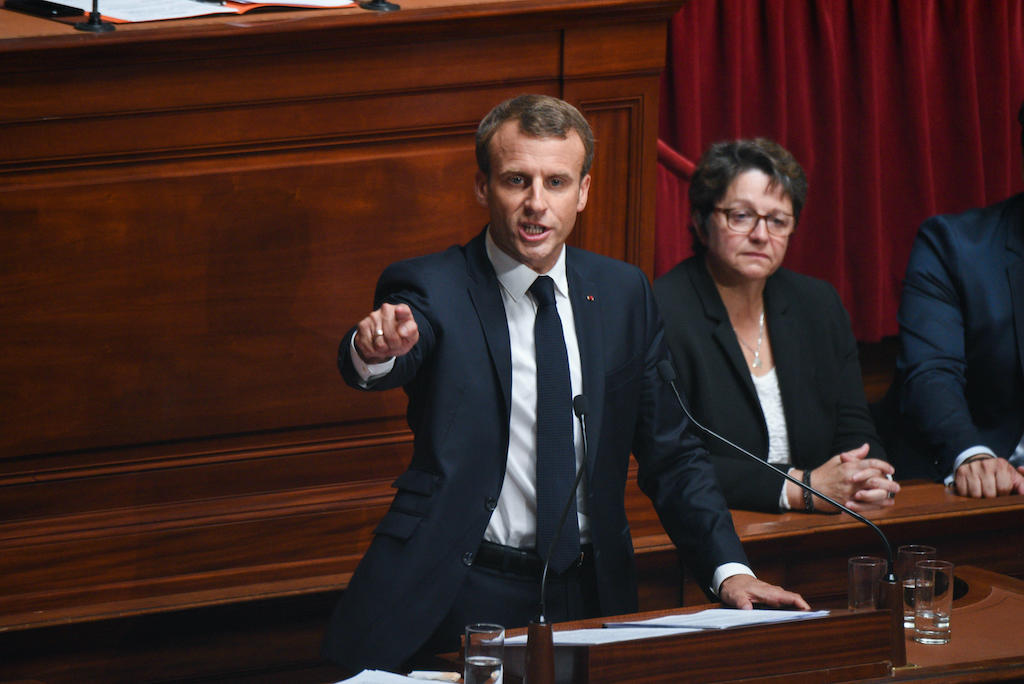
Meanwhile, National Rally has a history of climate scepticism. Under Le Pen it has embraced some environmental policies, but is still broadly opposed to strong climate action.
Beyond its domestic politics, France is one of the largest and most influential members of the EU and holds the presidency of the EU Council in 2022.
In this role, it has committed to pushing the “Fit for 55” package of climate legislation, as well as a carbon border adjustment mechanism and an instrument to combat imported deforestation. Meanwhile, the French government’s climate advisers have noted that the government needs to get its own domestic policies up to speed with enhanced EU ambitions.
Paris pledge
France’s emissions in 2018 were 361m tonnes of CO2 equivalent (MtCO2e), according to the CAIT database maintained by the World Resources Institute (WRI), which includes emissions from land use, land-use change and forestry (LULUCF).
Its per-capita emissions were 5.4tCO2e, lower than the global average and, notably, also lower than other large emitters in Europe, such as the UK, Italy and Germany.
(It is worth noting that the French High Council on Climate – HCC – a government advisory body, has a considerably higher estimate of 436MtCO2e for 2019.)
As a member of the EU, France has a joint nationally determined contribution (NDC) under the Paris Agreement that includes an overall target for cutting emissions in the entire bloc. French negotiators are part of the EU party grouping at UN climate talks.
The EU submitted an updated NDC, based on its “green deal”, in 2020, increasing its emissions reduction target from 40% to “at least 55%” by 2030, from the baseline of 1990.
Climate Action Tracker (CAT) – an independent analysis of climate pledges produced by three research organisations – rated the EU’s NDC target as “insufficient” for achieving the Paris Agreement temperature goals.
It noted that the EU must “ensure that climate policy measures adopted in Brussels are implemented by the member states” as there are currently discrepancies in compliance. France is one of the nations that has fallen behind on its targets.
Under the EU’s Effort Sharing Regulation (ESR), member states are assigned targets for emissions that do not fall under the EU emissions trading scheme (EU ETS), meaning those from buildings, road and domestic maritime transport, agriculture, waste and small industries. France’s relatively low power-sector emissions make this regulation especially relevant.
Prior to the green deal, the French target was to cut its ESR emissions by 37% from 2005 levels by 2030. A European Commission assessment of France’s National Energy and Climate Plan (NECP) covering the period 2021-2030 concluded that without additional measures the nation would only manage a 26% cut during this period.
With the commission now recommending a more stringent 47.5% ESR emissions cut to keep France in line with the updated EU-wide target, observers have noted that the nation is in urgent need of new measures to achieve its goal.
France also has its own domestic emission target for a 40% reduction in emissions by 2030, from 1990 levels and excluding LULUCF, which corresponds to a 41% reduction compared to 2005. The nation also has a 2050 net-zero emissions target.
As it stands, the country is not on track to achieve any of these targets. (See: Climate policies and laws.)
France also submitted a separate NDC document early in 2021 for its overseas territories that are not technically part of the EU, namely New Caledonia, French Polynesia, Saint Barthélémy, Saint Pierre and Miquelon and Wallis and Futuna.

The document noted that these islands made up 1.6% of France’s total greenhouse gases in 2018 and that they would cut their emissions by 8.4% by 2030 compared to a 2016 baseline.
France is one of the more generous providers of climate finance to developing countries, ranking third after Japan and Germany, according to the Organisation for Economic Co-operation and Development (OECD). However, the majority of French funds are provided as loans, rather than grants.
Finally, French leaders were instrumental in the negotiations that, ultimately, yielded the Paris Agreement. Specifically, then-foreign minister Laurent Fabius served as COP21 president, and Laurence Tubiana, who was France’s climate ambassador during the talks, is often referred to as an “architect of the Paris Agreement”. (Tubiana is now chief executive of the European Climate Foundation, which funds Carbon Brief).
Climate policies and laws
France’s climate policies have come under considerable scrutiny in recent years as it has become apparent that the nation is not on track to achieve the targets it has set for itself.
A key reference point for today’s climate policies is the 2015 Energy Transition for Green Growth law, described by ecology minister Ségolène Royal at the time as “the most advanced and ambitious piece of environmental legislation in Europe, and probably the world”.
The law included some important targets, notably cutting emissions by 40% by 2030, compared to 2019 levels – excluding LULUCF – and by 75% by 2050.
It also included goals for ramping up renewables, ramping down nuclear and increasing the carbon tax on fossil fuels more than four times.
The framework introduced two tools to help drive France’s energy transition, both of which the government is mandated to publish every five years. These are the National Low-Carbon Strategy (SNBC) and the Multiannual Energy Programme (PPE).
The SNBC functions as France’s “roadmap” for cutting emissions, setting five-year carbon budgets to guide the transition towards its long-term targets.
The PPE is meant to complement the SNBC, setting five-year plans that cover energy consumption, networks and security.
Shortly after the 2017 election, the new Macron government produced a “climate plan” that included a number of notable commitments, such as a 2050 net-zero target, ending sales of petrol and diesel cars by 2040 and stopping fossil-fuel exploration on French soil by 2040.
Two years later in 2019, the Energy and Climate law enshrined many of these targets into law, including the net-zero goal which amounts to an 85% emissions cut by 2050, excluding LULUCF.
The law also established the HCC as a permanent body tasked with assessing the nation’s progress towards its climate targets. Its most recent report, published in 2021, concluded that France was on track to miss both its 2030 and 2050 goals under existing policies.
France already missed the target set in its first carbon budget under the SNBC, which covered 2015-2018, by a total of 65MtCO2e for the five-year period. The government has since revised its second carbon budget upwards and estimates that it will achieve this one, partly due to the impact of Covid-19.
In late 2020, at the suggestion of the HCC, four ministries were asked to submit their own roadmaps for achieving SNBC goals – namely those covering ecological transition, economy, finance and “territorial cohesion”, or housing.
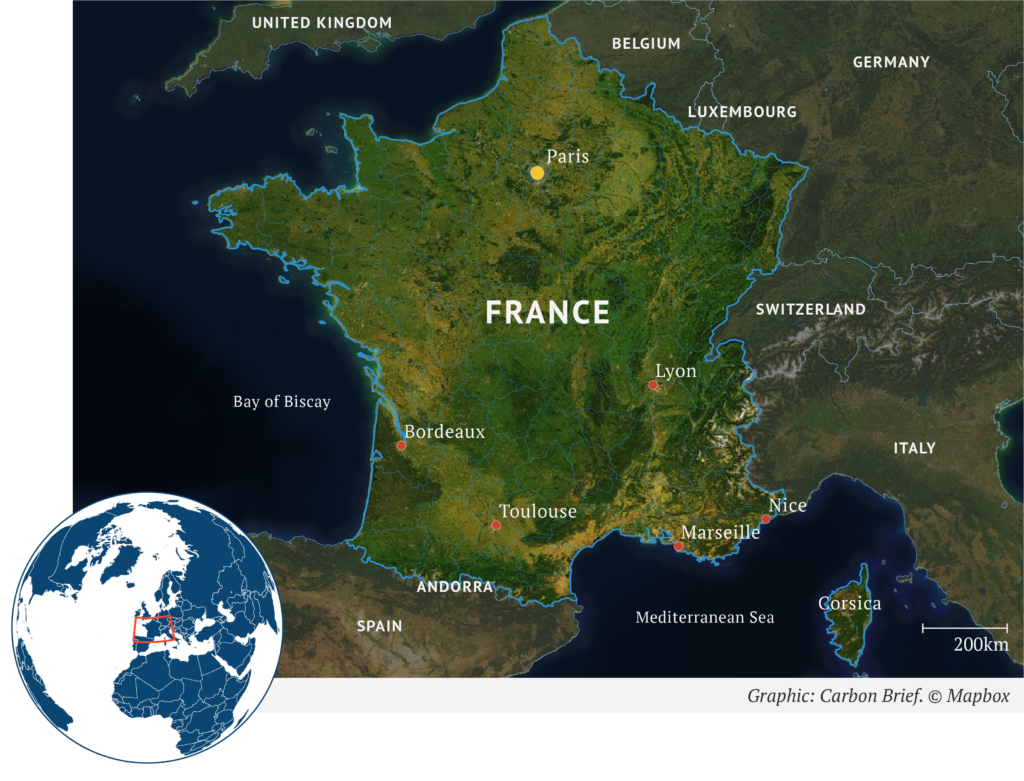
As the nation’s shortcomings on climate have become apparent, a series of events have pushed the government to up its ambition in recent years. In April 2019, responding to the “yellow vests” protests, Macron pledged to engage in “grand debate” with the French people about their concerns.
One component of this was the Climate Convention, a 150-member strong citizen assembly which was tasked with devising a series of measures in answer to the question:
“How to reduce greenhouse gas emissions by at least 40% by 2030, in a spirit of social justice?”
The president said he would submit their proposals “without a filter” either to a referendum, a vote in parliament or direct implementation.
The resulting 149 measures were passed onto the president himself, who committed to retain 146 of them.
Ultimately, the Climate and Resilience law, which passed in 2021, included many of the convention’s recommendations.
However, many campaigners and politicians were unhappy with the result, which they said had been significantly watered down after months of pushback from the president and right-wing parties in parliament. Measures to insulate homes and curb domestic flights were among those that were weaker than the measures originally proposed by the convention.
Meanwhile, two court cases were filed against the French government in 2019 over its inaction on climate change.
The first, filed by the municipality of Grande-Synthe, saw the Council of State – French supreme court – order the government to “take all the measures necessary” by the end of March 2022 to get France on track to meet its climate goals.
The council noted that during its first carbon budget period France had only achieved an average reduction in its emissions of 1% per year, rather than the 2.2 % required.
In the second case, a group of NGOs took the French state to court in an event dubbed the “case of the century”. They were also successful and the court found the state guilty of “non-respect of its engagements” concerning climate change.
The court ruled that the state must take immediate action to comply with its emissions targets and repair the damages caused by inaction. In practice, this means adding its overshoot from the first budget period to its target for the end of 2022, although it cut the overshoot amount to 15MtCO2e, taking into account the Covid-related drop in emissions in 2020.
Despite the urgency of these rulings, most candidates in the presidential election have not prioritised them in their messaging.
As well as domestic laws, France must also abide by those set at EU level. In 2020, France released its most recent National Energy and Climate Plan (NECP) under the EU, covering the period 2021-2030.
This was based on the work already undertaken for the SNBC and the PPE and, as with its domestic targets, France is not on track to hit these EU targets, largely due to rising emissions from the transport sector. (See: Paris pledge.)
By 2023, France will once again have to update its NECP to align with the EU’s 2050 net-zero goal and the European Climate Law, which also sets a legally binding target of 55% emissions cut by 2030.
Nuclear
Nuclear is by far the biggest source of power in France, responsible for 69% of the nation’s electricity generation in 2021, according to Ember.
France generated 379 terawatt-hours (TWh) of nuclear power in 2021, just behind China which generated 408TWh.
This makes it the third largest nuclear generator in the world, responsible for around one-eighth of all the nuclear power that is produced – far ahead of other major players such as Russia and South Korea. The dominance of nuclear in the French grid can be seen in the chart below.

France is also the world’s largest net exporter of electricity, primarily due to its traditionally cheap nuclear power generation. This remained the case in 2021, despite outages leading to the lowest French nuclear availability levels in recent history.
Nuclear has a long history in France, with prime minister Pierre Messmer responding to the 1973 oil crisis by instigating the construction of 13 nuclear reactors to promote energy independence.
Despite its dominance, the ageing fleet and high costs of constructing new reactors mean that nuclear power in France remains a relevant political topic today. A project underway at Flamanville in northern France is facing lengthy delays and is expected to cost around four times the initial estimate.
In French politics, particularly on the right, much of the contemporary climate debate centres around nuclear power. Amid the on-going energy crisis, many politicians have emphasised its potential to provide energy sovereignty.
The nuclear lobby, including EDF, the largely state-owned company that manages the country’s 56 reactors across 19 sites, also exerts a strong influence.
Broadly speaking, left-wing political parties in France are more opposed to nuclear power, often advocating for a gradual phase down and move to renewables – although the French Communist Party supports it.
Under Socialist president Hollande there was a goal of lowering French dependence on nuclear power to 50% of electricity generation by 2025.
While Hollande made no significant progress in closing any reactors, when Macron took over he initially aimed to take up his predecessor’s target. Environment minister Nicolas Hulot, a popular environmentalist and vocal critic of nuclear power, said in 2017 the government would shutter 17 of the nation’s 58 reactors by 2025.
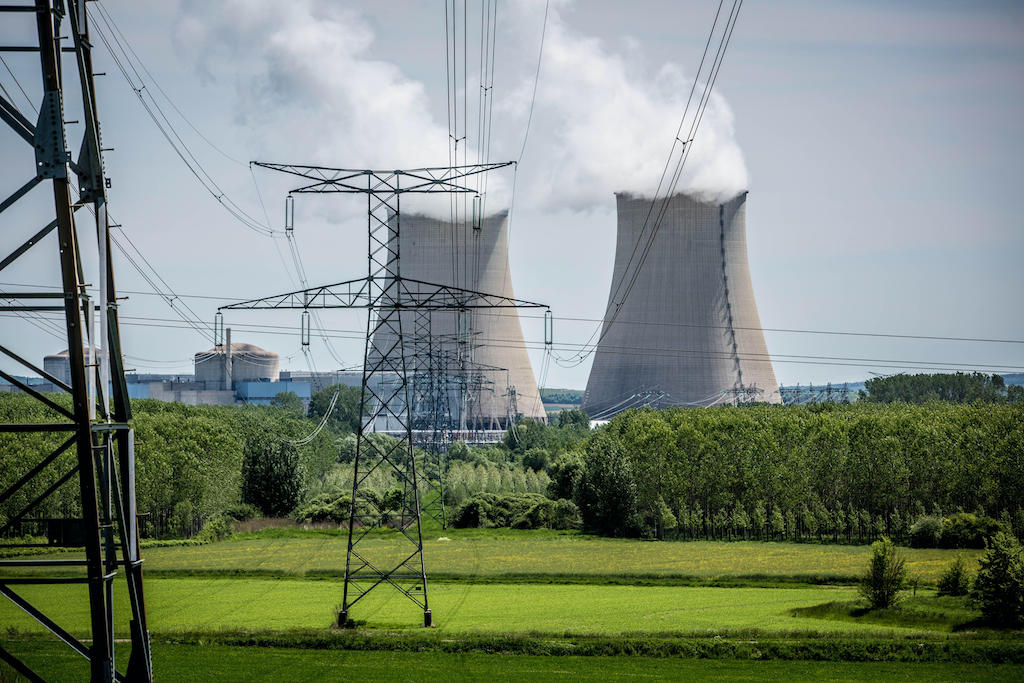
However, since then the centrist government has changed tack, following warnings by French grid operator RTE that shutting down some of the nation’s older nuclear reactors alongside all of its coal plants could result in supply shortages.
Macron, himself a supporter of nuclear power, said in a speech at the time: “Nuclear is not bad for carbon emissions, it’s even the most carbon-free way to produce electricity with renewables”. Hulot said the government would instead work towards a 2030-2035 timeframe for phasing it down.
A year later the minister, reportedly frustrated by the slow progress on nuclear, resigned from the government. Shortly afterwards, a new government energy plan confirmed the delayed date of 2035 for closing some reactors, while stating that the option to build new ones remained.
In early 2022, Macron announced plans to build six new reactors and to consider building a further eight, highlighting the need for independence from fossil fuels. The president also said he would seek to extend the lives of all existing reactors where possible.
This is in line with a report released by RTE at the end of 2021, which concluded that the cheapest path to net-zero emissions for France would involve 14 large new nuclear reactors, as well as a fleet of small modular reactors. It proposed a total fleet of around 40GW of new and old reactors in 2050 (currently France has 61GW).
Renewables
As it stands, France is far behind many of its European neighbours in constructing wind and solar power. It was the only EU member state not to reach its 2020 renewables target.
While the bloc as a whole overachieved on its goals, French renewables only accounted for 19% of the nation’s energy consumption, far from the 23% target imposed by the bloc’s Renewable Energy Directive (RED) in 2009.
Under the commission’s RED reform proposal, the next target for renewables would be increased from 32% of the EU energy mix by 2030 to 40%, meaning France will be even further off track.
According to Ember, in 2021 just 37TWh – 7% of France’s power generation – came from wind and 15TWh – 3% of power – from solar.
This relatively slow progress is partly related to the country’s reliance on nuclear power, but the ageing nuclear fleet and need to electrify much of society means there is still a need to expand French renewables. RTE envisages a 35% increase in electricity demand to decarbonise the transport and industrial sectors by 2050.
In 2015, the French government’s Energy Transition for Green Growth Act set a target of 40% of electricity generation to be sourced from renewables by 2030.
Three years later, the Multiannual Energy Programme (PPE) mandated by the act laid out a set of objectives for the coming decade. These include the development of a new offshore wind energy sector, the tripling of onshore wind generating capacity and a fivefold increase in solar capacity by 2030.
Construction of windfarms, in particular, has been slow, with many subject to arduous planning processes and legal challenges that delay proceedings.
Wind power has been a highly politicised topic in France, with local activists often protesting that turbines – even offshore ones – ruin the landscape and many right-wing politicians attacking them as a result. National Rally leader Le Pen has said she would get rid of renewable power subsidies and demolish existing turbines.
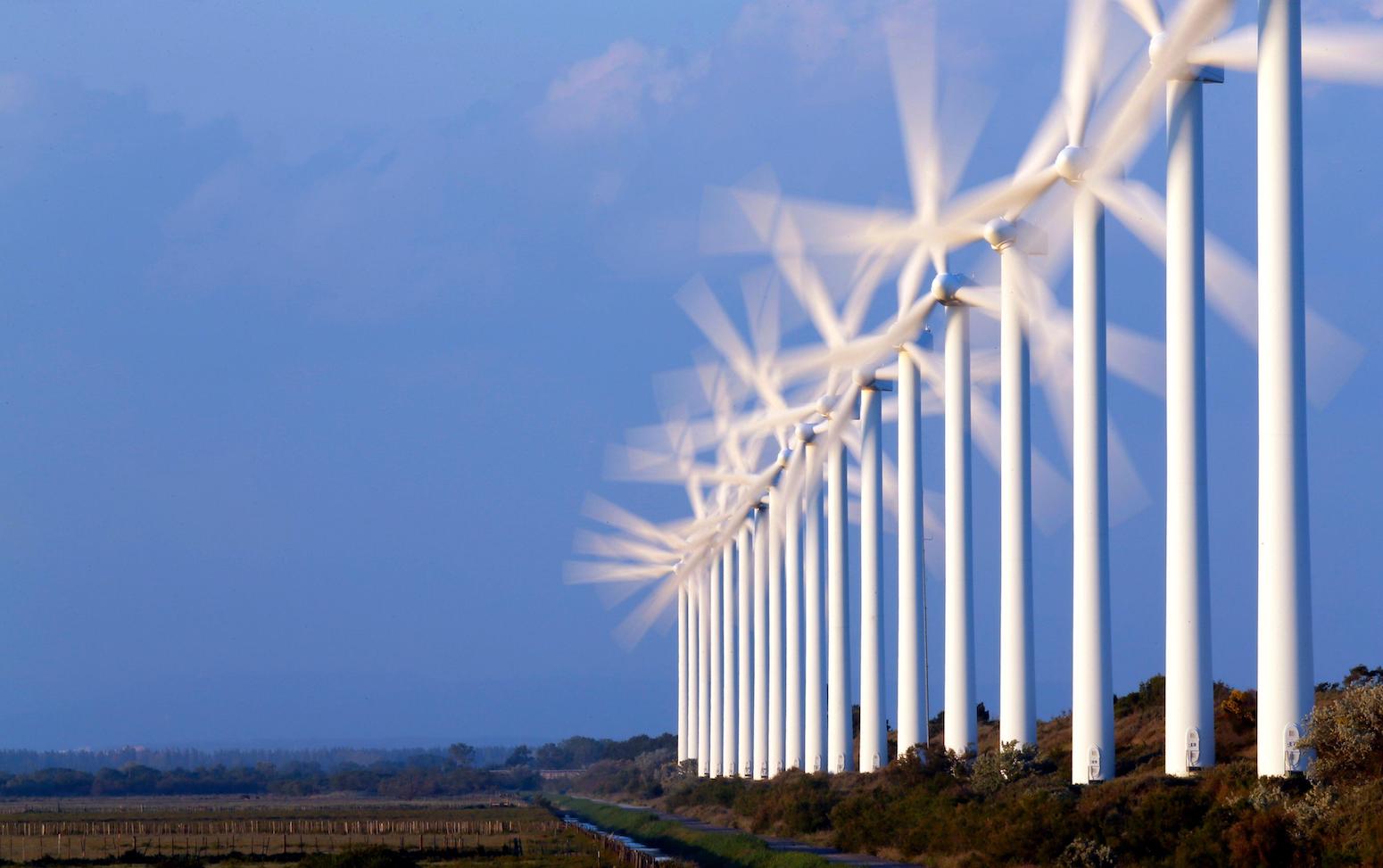
However, polling released in 2021 shows that three-quarters of the French public have a positive view of wind power – and the figure is identical for those living 5km or less from turbines. (The same poll showed that only 58% think nuclear power should have a key role in France’s energy mix.)
Nevertheless, this opposition has resulted in the government turning its attention away from onshore wind and towards offshore.
France’s first offshore windfarm will come online at Saint-Nazaire in 2022 and Macron has announced plans for around 50 offshore facilities with a combined capacity of 40GW by 2050. The president also committed to easing the permitting hurdles facing the industry.
France has done better on constructing hydropower, with its 60TWh of generation in 2021 making it the fourth largest producer of hydroelectricity in Europe after Norway, Turkey and Sweden.
In 2018, the government set a target to increase hydropower installed capacity in France by roughly 500MW to 26GW by 2023.
Fossil fuels
Owing predominantly to its abundance of nuclear power, France is less reliant on fossil fuels than many other industrialised nations and, in fact, generates less power from coal, gas and oil than any other member of the G20.
As of 2021, France produced 33TWh of electricity using gas, 6% of its total, and 10TWh using oil, 2% of its total, according to Ember.
The nation relies heavily on petrol and diesel for its vehicles, but, even when considering energy supply in its entirety, France relies less on fossil fuels than any other G20 country.
This also means that following Russia’s invasion of Ukraine and the ensuing sanctions from European nations, France has been less impacted than some of its neighbours. However, it still receives 20% of the natural gas it uses from Russia.
Coal has never been a major source of power in France, but over the past decade it has slowly been vanishing from the nation’s electricity supply. In 2021, just 6TWh of power came from coal, or 1% of total generation.
In 2018, the French government announced that all of its remaining coal plants would be shut down by 2022. As of January 2022, the nation still had 3GW in operation, according to the Global Coal Plant Tracker.)
France is home to TotalEnergies, Europe’s biggest oil company after Shell, although its domestic activities are mainly confined to refining and petrochemicals rather than extraction.
In fact, the nation’s domestic oil-and-gas production is tiny, meaning it is almost completely reliant on imports from countries such as the Netherlands, Norway and Saudi Arabia.
Its 2011 ban on fracking and decision in 2017 to legislate a ban on oil-and-gas exploration in its territories by 2040, while noteworthy, were therefore largely seen as symbolic. However, the latter did have significance for the overseas territory of French Guiana, which has been targeted for drilling.

France is also one of many nations that produce negligible volumes of fossil fuels to have joined the Beyond Oil and Gas Alliance (BOGA) at COP26, a group that is calling for a fixed date to end fossil fuel exploration entirely.
Homes are major consumers of fossil fuels in France due to their heating requirements, although emissions from the buildings sector have fallen over the past decade. Government figures show 40% of energy used to heat homes comes from gas and 12% from fuel oil.
France has had some success electrifying its heating, with another 12% of energy used to heat homes coming from electrical systems. France has more heat pumps than most neighbouring countries, but nowhere near as many as Scandinavian nations.
The government has taken steps to phase out fossil fuels in buildings, including banning the installation of oil and coal boilers in most new and existing buildings from July 2022, and pledging to replace all oil boilers by 2028.
Moreover, as part of the government’s “resilience plan” to wean France off Russian gas, it has modified its “MaPrimeRenov” subsidy scheme so that it no longer supports gas boilers and boosts support for heat pumps and biomass heaters, until the end of 2022.
According to the government, 7m French homes are poorly insulated and 14% of French people are “cold in their homes”. Its energy renovation plan for buildings includes a target of 500,000 buildings being renovated and insulated each year.
While this plan has been lauded by French ministers and energy-efficiency measures received a boost in France’s Covid-19 recovery package, the Institute for Sustainable Development and International Relations (IDDRI) thinktank has described progress as “timid”.
Finally, France’s emissions from heavy industry are lower than some of its more industrialised European neighbours and have fallen by around two-fifths since 1990, but are still responsible for 19% of total emissions.
While the HCC says that some measures in France’s Covid-19 economic stimulus package encouraged such industries to decarbonise, it also encouraged the further use of fossil fuels and broadly speaking policies for this sector are “only partially aligned” with the nation’s climate goals.
Transport
As the sector that produces more emissions than any other – and has been gradually increasing its share for decades – transport is a significant target for decarbonisation in France.
According to the HCC, transport produces 31% of French emissions, of which more than half are attributable to private cars.
The government has announced that sales of new petrol and diesel cars will be banned in France from 2040, a policy that was set into law in 2019.

France must now contend with an EU commitment to end the sale of combustion engine cars by 2035, something that the nation reportedly resisted during negotiations.
The HCC has recommended that to get the country back on track for its climate goals, the ban could be brought forward to 2030. For now, the government has merely banned the sale of cars emitting more than 95g of CO2 per km by 2030.
France had one of the largest electric car markets among large European economies, making up around 15% of car sales in 2021, according to the IEA. Despite significant increases in recent years, it has a long way to go to decarbonise its fleet.
Measures to boost electric-vehicle sales were a key component of the government’s Covid-19 green recovery package, with grants to support people buying low-emissions vehicles. The package also included a €5bn bailout for Renault, a core part of the nation’s sizable automotive industry.
In 2019, alongside the combustion engine ban the government also released a new transport law that included a series of measures to promote low-emissions vehicles and triple the number of trips taken by bike by 2024.
Various other policies implemented by the French government in a bid to cut emissions include grants for the purchase of electric bikes, subsidies for service stations to install electric vehicle charging points and a requirement that car advertisements include messaging about low-carbon forms of transport.
Despite all of these efforts, French transport emissions have hardly changed for a decade, barring the impact of Covid-19.
One key measure that has been highly controversial as a means of cutting transport emissions is the carbon tax, which had little impact for the first four years of its implementation from 2014 to 2018. This was partly due to oil prices falling and cancelling out the increase in taxation.
In response, Macron’s government planned to raise the tax from €44.60 to €86.20 per tonne of CO2 from 2018 to 2022.
This move marked the start of the “yellow vests” actions, with protesters concerned about the impact on fuel prices donning the high-visibility vests all French drivers must carry in their cars. In the end, the government kept the tax frozen at 2018 levels.
In Paris, the Socialist mayor Anne Hidalgo has received widespread praise for her target of banning cars from the city centre by 2022 – now delayed until 2024 – while expanding the capital’s cycle infrastructure. However, she has also faced significant opposition to the plans, and her bid for the French presidency saw her receive just 2% of the vote.
Little progress has been made to decarbonise other forms of transport. One exception is a recent move to ban short-haul domestic flights when the same journey could be made by train in under two-and-a-half hours.
This policy, a result of the Climate Convention, was – like many of the convention’s outcomes – weaker than the original proposal from the citizen’s assembly, following backlash from the aviation sector and some French regions.
Agriculture
Farming accounts for 19% of French emissions and the 9% reduction that has taken place since 1990 is at a rate that is “insufficient” in light of the government’s climate targets, according to the HCC.
The slight decline in emissions has resulted from a reduction in the size of the nation’s cattle herds and the use of livestock manure in fermenters, both of which have helped to cut methane emissions.
The HCC also notes that to stay on track for France’s net-zero target, the size of the country’s carbon sink must increase by 20%. It attributes the current shortfall to a decrease in the CO2 absorption of French forests and meadows, and the “continued artificialisation of soils”.

Agriculture is viewed as culturally and politically important in France, which is the world’s sixth largest agricultural producer and the largest in the EU. Despite this, it only makes up 1.6% of the nation’s GDP, according to the World Bank.
Compared to other sectors, there have been relatively few policies specifically aimed at cutting agricultural emissions in France, although an agriculture and forestry law in 2014 included some relevant elements.
The Climate and Resilience law in 2021 also included measures that targeted the food sector, such as the “eco-nitrogen plan”, which aims to cut the use of nitrogen fertilisers in an effort to lower nitrous oxide emissions by 15% from 2015 levels by 2030, with a new tax introduced if this goal is not met.
Another striking policy within the new law is an obligation for school canteens to offer vegetarian menus at least once a week, a move that has provoked some controversy in a nation renowned for its meat-heavy cuisine.
As a member of the EU, France is subject to the Common Agricultural Policy (CAP), a contentious system that is widely regarded as holding back efforts to tackle the bloc’s farming emissions.
France is the largest recipient of CAP spending, with 17% of the total, as well as a strong farming lobby and a longstanding history of supporting the policy.
While many NGOs and experts concluded that the latest round of CAP reforms would have little impact on cutting European emissions, the French agriculture ministry welcomed the deal that was reached and said in a statement that it would see environmental ambition “strengthened throughout the EU”.
For their part, the main French agriculture union FNSEA said climate spending incentives had been set “too high”.
Following Russia’s invasion of Ukraine and the subsequent impacts on food production, French farm lobbyists and the agriculture minister Julien Denormandie have pushed for EU environmental provisions for farming, including its overarching Farm to Fork Strategy, to be overturned.
Impacts and adaptation
The surface area of mainland France is the largest of EU member states, covering around 13% of the bloc’s area and spanning a range of climatic conditions. According to the HCC, “two-thirds of the French population are already strongly or very strongly exposed to climate risk”.
Heatwaves linked to global warming have killed thousands of French people in recent years and in 2019 the southern village of Gallargues-le-Montueux reached the highest temperature ever recorded in the country – 45.9C.

Drought threatens the arable crops and vineyards of southern France, wildfires are a growing risk in the Mediterranean region and glaciers in the French Alps are receding as temperatures rise.
Meanwhile, France’s Caribbean territories, such as Guadeloupe and Saint Barthélemy, are at risk from hurricanes, which are becoming stronger and more dangerous as a result of climate change.
Overall, the annual mean temperature of mainland France over the past decade was already 1.8C warmer, on average, than it was during the pre-industrial period of 1895-1915.
France has had two national climate change adaptation plans (PNACC-1 and PNACC-2), covering the periods 2011-2015 and 2018-2022.
The latter was set out by Macron’s government as part of its broader “climate plan” in 2017. It was based on a consultation with 300 stakeholders and resulted in 60 proposals for action, which the HCC says “would benefit from a more ambitious trajectory”.


